Difference between revisions of "Glossary:Anti-aliasing (AA)"
m (→Post-processing methods: Added minor stuff + citation for MLAA (which have a higher performance impact than FXAA, both MLAA v1 and MLAA v2, btw)) |
|||
| Line 61: | Line 61: | ||
{{++}} Not confined to a particular manufacturer | {{++}} Not confined to a particular manufacturer | ||
{{++}} Seeks to reduce or remove the effects of temporal aliasing<ref>[[Wikipedia:Temporal anti-aliasing|Temporal anti-aliasing]]</ref> | {{++}} Seeks to reduce or remove the effects of temporal aliasing<ref>[[Wikipedia:Temporal anti-aliasing|Temporal anti-aliasing]]</ref> | ||
| + | {{--}} Causes significant blurring while in motion | ||
===Temporal Anti-Aliasing (TXAA)=== | ===Temporal Anti-Aliasing (TXAA)=== | ||
Revision as of 03:38, 17 August 2018
Graphics and video
Resolutions
Video settings
- Field of view (FOV)
- Windowed / borderless fullscreen
- Anisotropic filtering (AF)
- Anti-aliasing (AA)
- High-fidelity upscaling
- Vertical sync (Vsync)
- Frame rate (FPS)
- High dynamic range (HDR)
- Ray tracing (RT)
- Color blind mode
Hardware
For a list of games, see List of games that support anti-aliasing (AA).
Anti-Aliasing (AA) is a computer graphics technique that attempts to minimise the unwanted 'staircase' or jagged object outlines which occur due to the limited resolution in 3D-Renderers, essentially by 'smoothing' these lines.[1]
Example of Anti-Aliasing
| No Anti-Aliasing | 16x Anti-Aliasing |
|---|---|
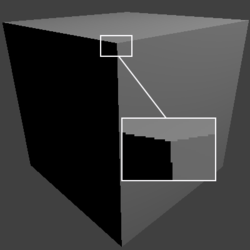 |
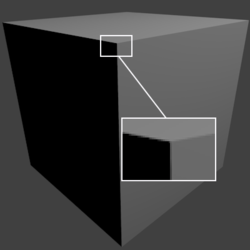
|
Types of Anti-Aliasing
There are a number of Anti-Aliasing techniques today but all of them are based on the same principle. They simply render multiple pixels per pixel of the final image.
The techniques only differ on two factors:
- How they determine which pixels are aliased.
- How they "mix" the multiple rendered pixels to get the final pixel.
Those algorithms are also variable on how many pixels they use to determine one final pixel. In video games this is represented by a simple number which is a power of 2 like 2x, 4x, 8x etc.
There are several terms associated with Anti-Aliasing, most of which are derivatives on the standard Anti-Aliasing formula.
Traditional methods
- The result is much sharper and cleaner than post-processing methods
- Forcing isn't guaranteed to work in games utilizing deferred shading[2]. This can be worked around by Downsampling, but with higher effect on performance
- Usually quite taxing on resources. Post-processing methods can be used as alternative for lesser performance hit
Super-Sampling Anti-Aliasing (SSAA)
- Also known as Full Scene Anti-Aliasing (FSAA) and often interchangeable with the term downscaling.
- Technically when implemented correctly, these do differ in that downscaling applies to an entire frame buffer – 2D and 3D Elements, while SSAA/MSAA are techniques only applied internally to 3D elements. In some implementations this can result in a lesser performance impact.
- Applies the general anti-aliasing formula to full screen images, reducing the "staircase effect". When compared to a rendered image undergoing MSAA, a SSAA/FSAA image will appear smoother. 2D text can also be effected by most downscaling implementations, while SSAA/MSAA should not effect text when implemented correctly.
- Has largely been replaced by less resource intense methods due to the huge stress it puts on the GPU, but due to the better result that it provides, some games still adopt it as an option in the in-game settings.[3]
Multi-Sample Anti-Aliasing (MSAA)
- Essentially a "budget" version of Super-Sampling
- To reduce the stress that SSAA/FSAA puts on a system, multi-sampling optimizes the process by evaluating each pixel only once, with true super-sampling only occurring at the edges of a rendered object, and to depth values. This results in a similar (but less drastic) improvement in visual quality whilst reducing the load put on the system to render and downscale such high resolutions.[4]
- Primarily clears up aliasing on geometry; temporal aliasing and aliasing from shader effects, textures and transparencies will not be affected.[5]
Coverage Sampling Anti-Aliasing (CSAA)
- QCSAA variant is supposed to increase the quality even further
- Nvidia GeForce 8000 Series and higher[6]
- Maxwell based GPUs such as GTX 750 Ti and GTX 800M/900 series removed the support[7]
- Aims to further reduce the additional stress that MSAA puts on the system, with Nvidia claiming that a CSAA-rendered image will rival 8x-16x MSAA whilst only putting a load on the system comparable to 4x MSAA. It does this by reducing the number of settings each sample determines (by creating a new sample for coverage) whilst increasing the overall number of samples.
Quincunx Super Anti-Aliasing (QSAA)
- Nvidia exclusive
- Improves on standard MSAA somewhat. For example, 2x QSAA roughly equates to 3x MSAA in terms of quality.[8]
Enhanced Quality Anti-Aliasing (EQAA)
- AMD Radeon HD 6900 series and higher[9]
- AMD claims it offers enhanced AA quality over standard Multi-Sample Anti-Aliasing modes by adding more coverage samples per pixel but keeping the same number of color/depth/stencil samples to achieve better AA quality than standard MSAA modes.[9]
Sparse Grid Super-Sampling Anti-Aliasing (SGSSAA)
- Nvidia exclusive
- Modern version of SSAA, possessing superior quality to other anti-aliasing methods at a steep performance cost.
- Comes in two forms: FSSGSSAA (Full Scene Sparse Grid Supersampling Anti-Aliasing) and TRSGSSAA (Transparency Sparse Grid Supersampling Anti-Aliasing).[10]
Temporal Anti-Aliasing (TAA)
- Not confined to a particular manufacturer
- Seeks to reduce or remove the effects of temporal aliasing[11]
- Causes significant blurring while in motion
Temporal Anti-Aliasing (TXAA)
- Nvidia GeForce GTX 600 series and higher[12]
- Film–style technique designed specifically to reduce temporal aliasing (crawling and flickering seen in motion when playing games)[13]
- Combines the raw power of MSAA with sophisticated resolve filters similar to those employed in CG films to produce a smooth image.[13]
Hybrid Reconstruction Anti-Aliasing (HRAA)
- Hybrid solution of hardware sampling, postprocessing, temporal and analysis[14]
Temporal Super-Sampling Anti-Aliasing (TSSAA)
- Also known as TMAA
- Applies anti-aliasing not only to the current frame but also to some frames that were rendered before, restoring the old positions of pixels by using their velocity. This creates smoother and more cinematic images in the game, while only slightly increasing the load on your video card.[15]
Multi-Frame Anti-Aliasing (MFAA)
- Nvidia GeForce GTX 900 series and higher[16]
- Meant to be used in conjunction with MSAA for lowered performance hit
- According to Nvidia it reduces performance cost while used with high resolutions and is more flexible to needs of different game engines due to its programmability.[17]
- One note of importance is that MFAA doesn't function properly below 40FPS. Below that threshold, MFAA causes smearing and blurring in motion.[18]
- Possibly also disable D3D11 Driver Command Lists, killing multi-threaded rendering (and thus performance when CPU-limited)[19]
Post-processing methods
- Less taxing on resources than traditional methods
- Applied after the image is rendered, unlike traditional methods. This means they are virtually compatible with every game, video or even still picture possible.
- Due to this, the image (textures in particular) can sometimes become blurry, so much that overall quality could become worse than the original if implemented poorly.
- Must be applied before rendering the HUD elements of a game, lest it affect them too.
Fast Approximate Anti-Aliasing (FXAA)
- Does not require large amounts of computing power. It achieves this by smoothing jagged edges ("jaggies")[20] according to how they appear on screen as pixels, rather than analyzing the 3D models itself as in conventional anti-aliasing
- However, the image quality improvement it provides is significantly less impressive than traditional AA methods such as MSAA.[21]
- Nvidia's response to AMD's MLAA.
Morphological Anti-Aliasing (MLAA)
- Available on AMD cards and can be forced for all games through the display driver control panel regardless of graphics API being used.
- Have a larger performance impact than FXAA.[22][23]
Subpixel Morphological Anti-Aliasing (SMAA)
- Image quality varies from game to game due to differing implementations, but it is arguably better than FXAA or MLAA[24]
Conservative Morphological Anti-Aliasing (CMAA)
- CMAA is positioned between FXAA and SMAA 1x in computation cost (1.0-1.2x the cost of default FXAA 3.8 and 0.55-0.75x the cost of SMAA 1x)
- Compared to FXAA, CMAA provides significantly better image quality and temporal stability as it correctly handles edge lines up to 64 pixels long and is based on an algorithm that only handles symmetrical discontinuities in order to avoid unwanted blurring.[25]
Quality comparisions
| Call of Duty: Ghosts | Elite: Dangerous |
|---|---|
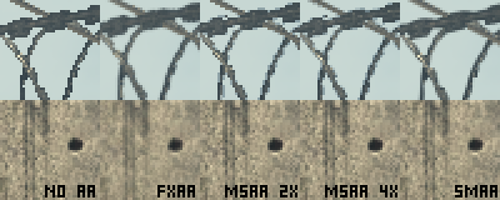 |
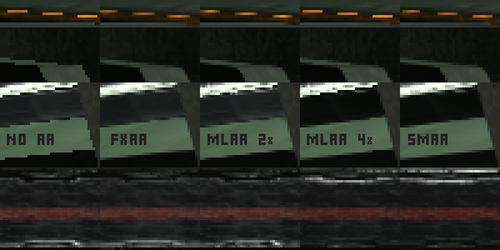
|
| Far Cry 4 | Shadow Warrior (2013) |
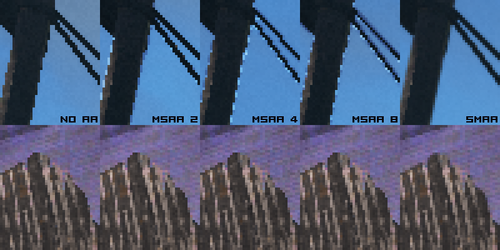 |
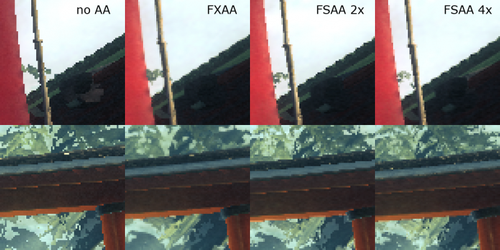
|
Forcing Anti-Aliasing
| Program | Available AAs |
|---|---|
| AMD Catalyst Control Center | MLAA, SSAA, MSAA, EQAA |
| injectSMAA | SMAA |
| Intel Control Panel | CMAA |
| NVIDIA Control Panel | FXAA, MSAA, CSAA, MFAA |
| NVIDIA Profile Inspector | FXAA, SSAA, MSAA, CSAA, QSAA, SGSSAA, MFAA |
| RadeonPro | FXAA, SMAA |
| ReShade | FXAA, SMAA |
References
- ↑ Anti-aliasing article on Wikipedia
- ↑ Deferred shading - Wikipedia, the free encyclopedia - last accessed on 2016-6-14
- "One more rather important disadvantage is that, due to separating the lighting stage from the geometric stage, hardware anti-aliasing does not produce correct results anymore since interpolated subsamples would result in nonsensical position, normal, and tangent attributes."
- ↑ Supersampling
- ↑ Multisample anti-aliasing
- ↑ Diving into Aliasing - Beyond3D - last accessed on 2016-6-19
- ↑ CSAA (Coverage Sampling Antialiasing) article - Nvidia.com - last accessed on 2016-4-29
- ↑ New nVidia Maxwell chips do not support fast CSAA - Real Hardware Reviews - last accessed on 2016-4-29
- ↑ MSAA and QSAA thread - Overclockers - last accessed on 2016-4-29
- ↑ 9.0 9.1 EQAA Modes for AMD 6900 Series Graphics Cards (PDF document) - last accessed on 2016-4-29
- ↑ SGSSAA - Natural Opinions - last accessed on 2016-6-14
- ↑ Temporal anti-aliasing
- ↑ TXAA supported GPUs on GeForce.com - last accessed on 2016-4-29
- ↑ 13.0 13.1 TXAA Technology on GeForce.com - last accessed on 2016-4-29
- ↑ HRAA Siggraph 2014 (PPT document) - last accessed on 2016-4-29
- ↑ Update 9.9: Graphics Changes - World of Tanks - last accessed on 2016-4-29
- ↑ MFAA supported GPUs on GeForce.com - last accessed on 2016-4-29
- ↑ Technology of MFAA on GeForce.com - last accessed on 2016-4-29
- ↑ NVidia Anti-Aliasing Guide (updated) thread - Guru3D - last accessed on 2016-4-29
- ↑ 3DMark Draw Calls, Single Threaded Faster - Guru3D.com Forums
- ↑ FXAA: Anti-Aliasing at Warp Speed - GeForce.com - last accessed on 2016-4-29
- ↑ Fast Approximate Anti-Aliasing (FXAA) - Coding Horror - last accessed on 2016-4-29
- ↑ HardOCP - NVIDIA's New FXAA Antialiasing Technology - last accessed on 2018-07-25
- ↑ Tom's Hardware - AMD Radeon HD 7870 And 7850 Review: Pitcairn Gets Benchmarked - last accessed on 2018-07-25
- ↑ SMAA: Enhanced Subpixel Morphological Antialiasing - last accessed on 2016-6-14
- ↑ Conservative Morphological Anti-Aliasing (CMAA) - Intel.com - last accessed on 2016-4-29
